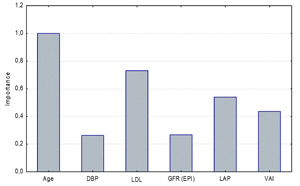Age-Specific Approach to Arterial Stiffness Prediction in Apparently Healthy Patients
DOI:
https://doi.org/10.14740/jocmr5271Keywords:
Arterial stiffness, Cardio-ankle vascular index, Predictive model, Metabolic parametersAbstract
Background: The high prevalence of traditional cardiovascular risk factors among the patients without cardiovascular disease (CVD) allows us to predict an increase in cardiovascular morbidity rate in the future. Arterial stiffness is one of the most important predictors and pathogenetic mechanisms of CVD development. The aim of our study was to evaluate the predictive differences of age-related and age-independent (universal) cardio-ankle vascular index (CAVI) reference values for detecting increased arterial stiffness in individuals without CVD.
Methods: The study included 600 patients (43% men and 57% women, mean age 36.0 ± 18.3 years). All the patients underwent anthropometric measurements with obesity markers evaluation, assessment of arterial stiffness by sphygmomanometry. To create predictive models, we used universal and age-related CAVI thresholds: ≥ 9.0 (CAVI≥ 9) and CAVIAge according to the “Consensus of Russian experts on the evaluation of arterial stiffness in clinical practice".
Results: In the < 50 years group, both the CAVIAge and CAVI≥ 9 models were significant (CAVIAge: b = 4.8, standard error b (st.err.b) = 0.27, P < 0.001; CAVI≥ 9: b = 3.2, st.err.b = 1.6, P < 0.001). The CAVIAge model demonstrated high sensitivity and specificity (> 70%) compared to the CAVI≥ 9 model (sensitivity 62%, specificity 58%). In the receiver operating characteristic (ROC) curve analysis, the CAVIAge model had a significantly higher area under the ROC curve (AUC) = 0.802 than the CAVI≥ 9 model: AUC = 0.674. In the ≥ 50 years group, both models were significant: CAVIAge (b = 2.6, st.err.b = 1.13, P < 0.001) and CAVI≥ 9 (b = 5.3, st.err.b = 0.94, P < 0.001). Both models demonstrated high sensitivity and specificity (> 70%). When ROC curves were analyzed for the CAVIAge model, the AUC value of 0.675 was significantly lower when compared to the CAVI≥ 9 model (AUC = 0.787, P = 0.031).
Conclusions: In the < 50 years group, the model based on age-specific CAVI thresholds has the higher predictive value, sensitivity, and specificity for identifying individuals with increased arterial stiffness. In contrast, in the ≥ 50 years group, a predictive model using a universal threshold value of CAVI≥ 9 has advantages.

Published
Issue
Section
License
Copyright (c) 2024 The authors

This work is licensed under a Creative Commons Attribution-NonCommercial 4.0 International License.









